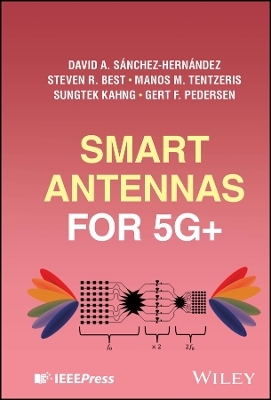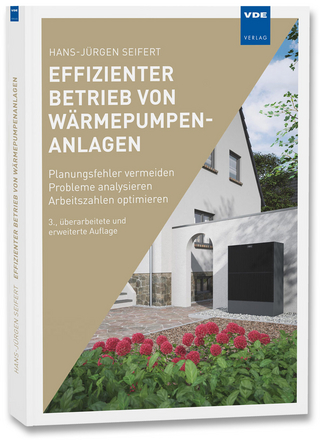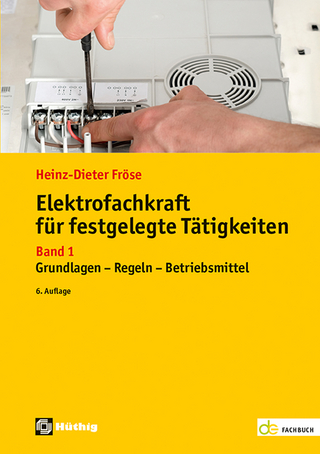
Smart Antennas for 5G+
Wiley-IEEE Press (Verlag)
978-1-394-21050-3 (ISBN)
Smart Antennas for 5G+ addresses the transformation that simple, conventional antennas have gone through to fulfill the complex and challenging performance expectations of 5G wireless communications and beyond. It also describes the 5G physical layer including the gNodeB, basics of the propagation channel, and user equipment (UE) specific antenna aspects. The authors present various broadband antennas covering mmW bands for 5G+ and B5G applications, explore recent developments in array calibration and plane wave generators, and consider future challenges for 5G+ radio system testing.
Novel key performance indicators in which not only conventional RF parameters, but also other parameters and overall radio performance, are examined. The huge shrinkage which was prioritized in 4G modules are now combined with extremely versatile and precise beamforming capacities, thermal mitigation, and link budget compensation design strategies that bring antennas into a new era. As such, antenna integration, flexible and 3D printed elements, the use of metamaterials, and advanced testing of new features are key elements of this book.
Additional topics covered in Smart Antennas for 5G+ include:
Beamforming, beam-steering, power control, cell breathing, and many other 5G concepts that make the evaluation of a 5G antenna structure a complex process
Multi-probe anechoic chamber, reverberation chamber, and wireless cable solutions, RF testing of the 5G antenna systems, and small-cell repeaters for 5G/B5G beamforming
Powering and sensing applications in 5G+ printed electronic steerable antenna arrays for reconfigurable intelligent surfaces that stem from metasurfaces
3GPP/ITU standards and models for 5G MIMO base station antennas, propagation channel modeling, and link budget considerations
The connection between complex but realistically used designs and the way testing has evolved to determine the value of novel designs makes Smart Antennas for 5G+ a must-have resource for advanced engineers as well as newcomers in the field of 5G wireless communications.
David A. Sánchez-Hernández, PhD, is a Full Professor holding the Antennas & Propagation and 5G Chair position at Universidad Politécnica de Cartagena, Spain, and founder of EMITE Ingeniería, S.L., Spain. Steven R. Best, PhD, is Senior Principal Electromagnetics and Sensor Systems Engineer with the MITRE Corporation, located in Bedford, MA. Manos M. Tentzeris, PhD, is an Ed and Pat Joy Chair Professor with the School of ECE at Georgia Tech, USA. Sungtek Kahng, PhD, is a Professor with Incheon National University, Head of Korea’s Ministry of Science and ICT-sponsored research and development center on RF and Satellite Communication and an Executive Director at the Korean Institute of Communication and Information Science and the Korean Institute of Electrical Engineering. Gert F. Pedersen, PhD, is a Full Professor heading the Antenna, Propagation and Millimetre-Wave Systems Laboratory at Aalborg University, Denmark.
List of Figures ix
About the Authors xix
Foreword xxiii
Acknowledgements xxv
List of Acronyms xxix
1 Introduction: The Path to 5G and Beyond 1
David A. Sánchez-Hernández and Steven R. Best
Introduction 1
2 The 5G Physical Layer 13
Steven R. Best
2.1 Introduction 13
2.2 The Physical and Data Link Layers 17
2.3 1G to 4G Cellular Networks 19
2.4 5g 22
2.5 Massive MIMO 24
2.6 The Importance of Antennas in 5G 26
2.6.1 The 5G gNodeB Advanced Antenna System (AAS) 27
2.6.2 Antennas for Sub-7 GHz 5G FR1 User Equipment 32
2.6.3 Antennas for mmWave 5G FR2 User Equipment 33
2.7 5G mmWave Link Budget Example (Downlink) 35
2.8 Conclusions 37
3 Fully Integrated 5G Broadband Antennas and Wireless Modules 39
Manos M. Tentzeris and Charles A. Lynch
3.1 Introduction 39
3.2 Broadband Antennas Covering the mmWave Bands for 5G and B5G Applications 41
3.2.1 3D and Inkjet Printing Broadband 5G AiP 41
3.2.2 Additive Manufacturing 5G Module with Broadband AiP 46
3.2.3 Semi-Additive Manufacturing Broadband 5G AiP on Glass Substrate 52
3.3 Additively Manufactured Shape-Changing Reconfigurable Frequency Selective Surfaces for mmWave/5G Applications 56
3.3.1 A Fully Inkjet-Printed FSSs Based on Origami “Eggbox” Structure with Four Degrees of Freedom 58
3.3.2 Novel 4D-Printed Miura-ori Origami-Inspired FSS Structure 63
3.4 5G+ Integrated Wireless Modules for Communications, Powering, and Sensing Applications 64
3.4.1 Energy-Autonomous Dual Rotman Lens-Based Harmonic mmID for Ultra-Long-Range Sensing 64
3.4.2 “Smart” Packaged Localizable mmIDs 69
3.5 Additively Manufactured Massively Scalable Electronic Steerable Antenna Arrays for Reconfigurable Intelligent Surfaces 72
3.6 Rotman Lens-Based 5G-Enabled Wireless Power Grid 77
3.7 Conclusions 81
4 Metamaterial 5G Beamforming Antennas 83
Sungtek Kahng
4.1 Mobile Handset Antennas for Sub-6-GHz Bands of B5G and 6G 83
4.2 Millimeter Wave Antennas for B5G and 6G 103
4.3 Metamaterial Antennas for B5G and 6G 122
4.4 Comparative OTA Test Results for B5G and 6G Antennas 128
4.5 Conclusions 142
5 Key Performance Indicators for 5G+ Terminal Antennas 145
David A. Sánchez-Hernández
5.1 Introduction 145
5.2 5G OTA Test Methods So Far 146
5.3 The Challenges for Effective 5G+ OTA Testing 156
5.3.1 Fully Integrated Antenna Arrays 156
5.3.2 DUT Form Factors 157
5.3.3 Spatial Agility 159
5.3.4 Channel Modeling 160
5.4 Some Effective 5G+ Key Performance Indicators 161
5.4.1 Averaged Spectral Efficiency 161
5.4.2 Beamforming SNR Increase (BSNRI) 163
5.4.3 Beamforming Battery Consumption 163
5.4.4 Beamforming Temperature Increase 163
5.4.5 Beamforming Capacity Gain 166
5.4.6 Beamforming Averaged Latency 169
5.4.7 End-to-End Latency 170
5.4.8 RF Latency 172
5.4.9 DL/UL FTP/TCP/UDP Throughput 173
5.4.10 True Throughput 174
5.4.11 Peak Downlink Throughput 174
5.4.12 Peak Uplink Throughput 175
5.5 Conclusions 176
6 Effective Testing of 5G Radios and Antennas 179
Gert F. Pedersen and Wei Fan
6.1 Introduction 179
6.2 Calibration Testing of the 5G Antenna Systems 180
6.2.1 Experimental Comparison of On–Off and All-On Calibration Modes 180
6.2.1.1 Measurement Campaign 182
6.2.1.2 Measurement Results 185
6.2.2 All-on Calibration Methods 186
6.2.2.1 Complex Signal-based Measurement 186
6.2.3 Amplitude-only Measurement 193
6.3 Performance Testing of 5G Radios 195
6.3.1 Standardization Processing in 3GPP 196
6.3.1.1 Measurement Methodologies 197
6.3.1.2 Channel Models 202
6.3.2 MPAC Results for 5G 207
6.3.2.1 Channel Validation Results 207
6.3.2.2 Typical Throughput Testing Results in 5G Trials 210
6.3.3 CATR Results for 5G 215
6.3.3.1 Working Principle 215
6.3.3.2 Validation 224
6.3.3.3 5G Test Results 227
6.4 Conclusions 232
7 Conclusions and Future Challenges 235
David A. Sánchez-Hernández, Steven R. Best, Manos M. Tentzeris, Sungtek Kahng, and Gert F. Pedersen
7.1 Conclusions and Future Challenges for 5G+ Radio System Testing 235
7.1.1 Antenna Design and Manufacturing Challenges 236
7.1.2 Standardized Testing 238
7.1.2.1 Mpac 238
7.1.2.2 Rts 239
7.1.2.3 Rc 240
7.1.2.4 Catr 240
7.1.3 Non-standardized Testing 241
References 243
Index 261
| Erscheinungsdatum | 09.11.2024 |
|---|---|
| Sprache | englisch |
| Gewicht | 699 g |
| Themenwelt | Technik ► Elektrotechnik / Energietechnik |
| Technik ► Nachrichtentechnik | |
| ISBN-10 | 1-394-21050-7 / 1394210507 |
| ISBN-13 | 978-1-394-21050-3 / 9781394210503 |
| Zustand | Neuware |
| Informationen gemäß Produktsicherheitsverordnung (GPSR) | |
| Haben Sie eine Frage zum Produkt? |
aus dem Bereich


